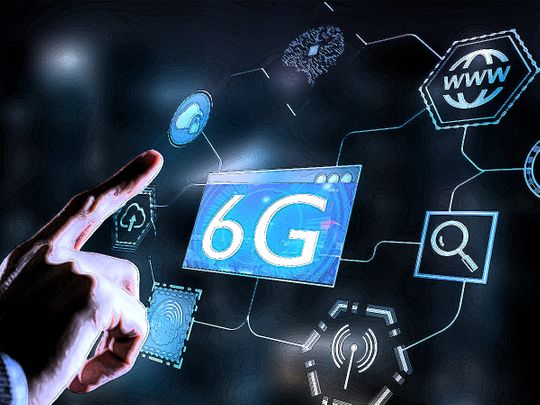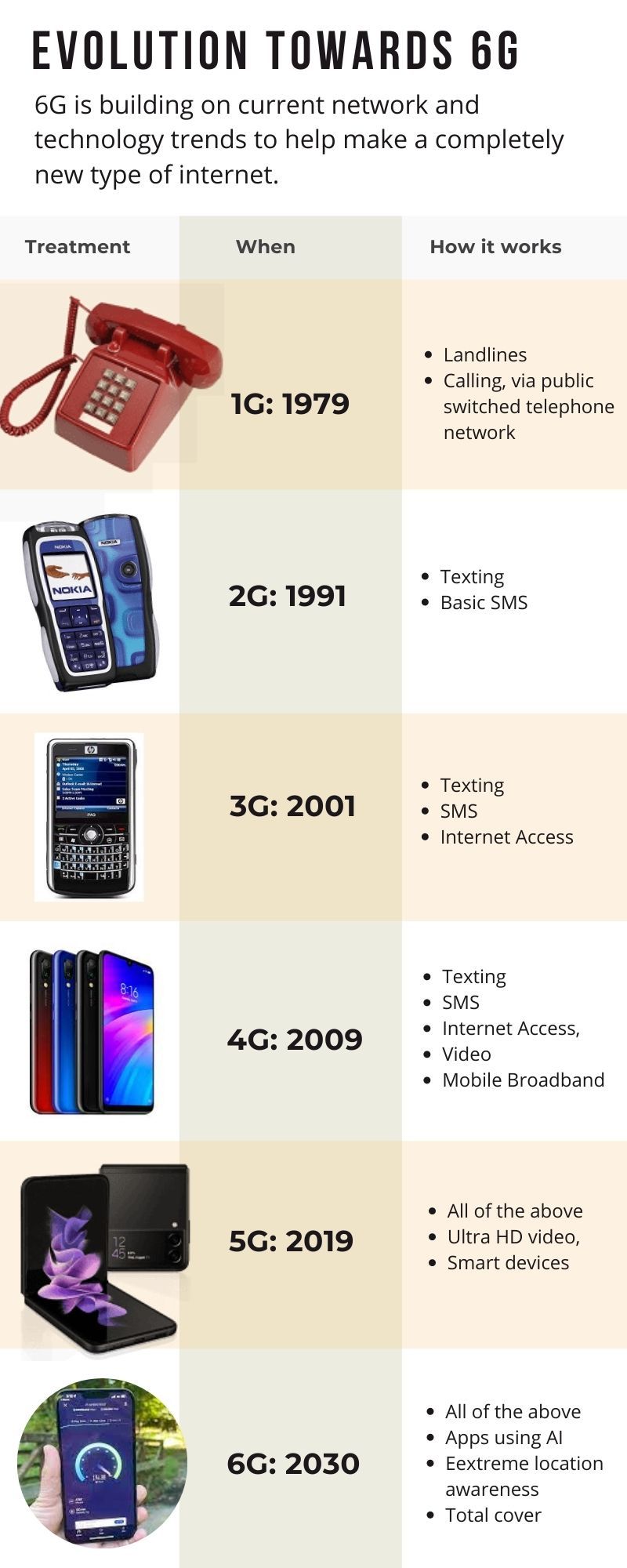
Highlights
- Big changes are about to happen in tech.
- Only 30% of the world's countries currently have access to 5G.
- The world’s leading nations and tech companies are racing to grab the 6G sweepstakes about to hit the tech world.
- Research & development focus on standards and services, such as always-on, device-to-device communication and Augmented Reality (AR) interface.
You’ve heard of 3G, 4G and 5G. Each one is a different different generation of wireless network. It’s a continuous progression that can be sometimes too fast to keep track of.
The whole point about it is that each one is so much more powerful than one before it. It ushers in a completely new change in society. So now, as 5G is just getting rolled out across the planet, 6G plans are already underway, possibly providing internet connections to outer space.
Here’s the low-down on 6G:
Does 6G really exist?
On paper, yes. As experimental networks, yes. Though 6G is just a breath away from 5G — but it’s actually a massive jump in functionality, speed and coverage. There's a flood of innovations, with at least 20,000 patent applications, related to 6G alone. Simply put, though still on trial stages, 6G has a good chance of making 5G a "has-been" in mobile data networking.

Some experts believe 6G could reach speeds of up to 1 Tbps, a 1,000 times faster than the 1 Gbps that current fibre optic packages can supply.
Theoretically, it form the framework of a fully-connected world of inexpensive, fast Internet service with super-fast wireless speeds and the ability to tap satellite communication networks using specially designed “nano-antennas".

What makes it different from 5G?
Theoretically, 6G could supersede the existing networks and help make a completely new type of internet. Using higher-frequency radio bands, 6G promises much faster speeds and lower "latency".
How much of the world has 5G today?
As of January 2020, commercial 5G networks have been deployed in 378 cities across 34 countries. Another estimate shows that as of February 2021, over 30% of the world's countries have access to 5G. Some estimates forecast that by 2025 — we'll reach 3.6 billion 5G connections.
So why is 6G necessary?
Let’s backtrack a bit. The first ever mobile phones were actually Zero G (0G). These were chunky devices with massive boxes for receivers. 1G was the first time the public can make mobile phone calls. 2G was texting (SMS); 3G was SMS and internet on mobile phone; 4G internet access, video and mobile broadband; 5G builds on 4G, plus ultra-HD video and smart devices.

We've all become mega consumers of internet data at record rates. Even as research on ultra-high speed communications continue to accelarate, the world is growing ever bandwidth-hungry, with people wanting for shorter latency (delays) and ever higher throughput (speed) for applications such as crypto mining and the upcoming "Internet of Everything" (IoE).
Researchers collaborating on the project have found that using what they call as Photonic Topological Insulators (PTI), they were able to create a small silicon chip with rows of triangular holes, and small triangles to transmit terahertz (THz) waves.
THz technology can potentially boost intra-chip and inter-chip communication to support Artificial intelligence and cloud-based technologies, such as interconnected satellites and self-driving cars, able to transmit data quickly to other nearby cars/satellites/infrastructure to navigate better, avoid accidents and connect seamlessly.
What are the key drivers of 6G?
The key technologies seen by experts as the driving force behind 6G are:
- The terahertz (THz) band
- AI
- 3D networking
- Unmanned aerial vehicles (UAV)
- Wireless power transfer
- Optical wireless communication
- Low-latency satellite communications

What are countries doing?
UAE
The UAE's telecom major etisalat already announced in June its ambitious 6G plans. The carrier has said it is upgrading capabilities of its R&D centre in preparation for 6G implementation.
China:
China is leading the 6G race. Of the estimated 20,000 6G-related patent applications filed, 40.3% originated from China, and 35% from the US, according to a new report. Nikkei Asia Review report said that the US and Japan, combined, matches China’s patent numbers. While most of these patents may not end up being strategic, some could prove optimal in giving it big-power edge.
On November 6, 2020, China has successfully launched what has been described as "the world's first 6G satellite" into space to test the technology. It went into orbit along with 12 other satellites from the Taiyuan Satellite Launch Center in the Shanxi Province. The satellite reportedly uses “Terahertz waves” that could send data at speeds several times faster than 5G.
India
India has formed a technology innovation group to make a 6G “action plan”. 6G is expected to be in telecom, healthcare, business, especially warfare. It is hoped that early lead in 6G may help India towards global tech leadership.
India, which has rolled out a national ID project for its 1.3 billion inhabitants, is on its way to connect 600,000 villages to broadband network, as government seeks to transform key sectors from services to agriculture. In October, Indian media reported that Telecom Secretary K Rajaraman has asked state-owned telecom R&D organisation C-DoT to start working on 6G in order to catch up with the global market in time.
India itself is on its way to connecting 600,000 villages with broadband. All of India’s sectors are undergoing a digital transformation. The country is investing in developing indigenous capabilities in telecom technology such as 5G & 6G.
Europe

Hexa-X is the joint European initiative to shape 6G. It is a flagship project of the European Commission (EC). On January 12, 2021, Hexa-X kicked-off an online consortium meeting with 140 participants. The group stressed on the need of the flagship research project to define the future of 6G.
South Korea
In South Korea, LG reported in August 2021 that it has completed its first successful test of 6G over 100 meters in an outdoor setting. The tech giant has taken oon the task of developing 6G to push internet speeds even faster than 5G. In this demo, LG engineers successfully demonstrated the transmission and reception of wireless 6G terahertz data over 100 meters in an outdoor setting. Also, LG demonstrated adaptive beamforming as well as high gain antenna switching technology.

Japan
Japan has also announced plans to roll out 6G — a new technology that will be 10x faster than the current 5G — by 2030.
America
In October 2020, the Alliance for Telecommunications Industry Solutions (ATIS) launched a partnership with AT&T, Verizon, T-Mobile, Microsoft, Samsung, and others to develop the next generation of internet technologies in North America. In April 2021, US President Joe Biden and Japanese Prime Minister Yoshihide Suga have agreed to jointly invest $4.5 billion for the development of next-generation communication known as 6G, or “beyond 5G.” Apple and Google are among the latest to join the 6G alliance. US labs are also developing performance targets for 6G.
An area being developed includes fully AI-enabled, always-on device-to-device communication and Augmented Reality interface. US operator Verizon currently offers 5G broadband internet, called 5G Home, in 60 cities. Currently, 5G is available in around 100 US cities, while 5G Plus is live in parts of 38 cities.
What is the future of 6G technology?
Imagine going beyond the Internet of Things (IoT) — your kitchen, room, vehicle fleet — to the Internet of Everything (IoE). That, in theory, is what 6G could provide.
The intensity of competition, among countries and between companies, the speed of innovation (20,000 patent applications for 6G alone), as well as the confluence of cheaper, faster computing power and communications technology will take the world to a future yet to be imagined by most of us.








